Mad Hedge Biotech & Healthcare Letter
April 22, 2021
Fiat Lux
FEATURED TRADE:
(THE PFIZER OF ANIMAL HEALTHCARE IMPRESSES WITH GROWTH DRIVERS)
(ZTS), (PFE), (ELAN), (IDXX)

Mad Hedge Biotech & Healthcare Letter
April 22, 2021
Fiat Lux
FEATURED TRADE:
(THE PFIZER OF ANIMAL HEALTHCARE IMPRESSES WITH GROWTH DRIVERS)
(ZTS), (PFE), (ELAN), (IDXX)

The World Health Organization has yet to offer definitive proof that animals can infect humans with COVID-19.
However, there had been cases where humans infected the animals, including tigers, minks, lions, and domestic cats and dogs.
This might seem insane to some since we’re not even done vaccinating humans yet, but it definitely presents a large and potentially lucrative market.
Recently, Russia launched the first and only registered COVID-19 vaccine for animals, Carnivac-Cov.
Not to be outshone, Zoetis (ZTS), the leader in animal healthcare in the United States, also started working on its own COVID-19 vaccine.
In fact, Zoetis has already commenced testing its candidate on some great apes at San Diego Zoo earlier this month.
So far, the company administered two vaccine shots to three gorillas, four orangutans, and six bonobos.
Zoetis’ efforts date back to last year when news broke that dogs and cats in Hong Kong were also getting infected with COVID-19.
While the USDA has not yet approved the vaccines for dogs and cats, the organization is leaning towards giving the green light for minks.
As it turns out, minks are extremely susceptible to COVID-19, so vulnerable that Denmark actually ordered a mass culling of millions after an outbreak in November 2020.
To date, several zoos have already reached out to Zoetis to avail of its experimental COVID-19 vaccine.
Considering that all these started with the cross-species transmission, experts are also hoping to learn more about it with the help of the company to prevent future pandemics.
Zoetis is ideally positioned to lead this charge since it’s the frontrunner in the pharmaceutical sector for pets and livestock.
This company used to be a branch of Pfizer (PFE), but was later spun off in 2012 to stand on its own.
In terms of competitors, the two most relatable companies to Zoetis are Elanco Animal Health (ELAN) and IDEXX Laboratories (IDXX).
Both offer virtually the same products, but Zoetis is the biggest among the three with approximately $75 billion in market capitalization.
In comparison, IDXX has roughly $41.55 billion, while ELAN has $13.61 billion.
Knowing that there’s more than a single way to expand its business, Zoetis has been favoring acquisitions as one of its growth options.
In the past years, Zoetis has been on a buying spree, making no less than eight acquisitions so far.
Half of these are geared towards veterinary diagnostics, with the intention of dominating the fastest-growing sector of the animal healthcare industry.
All its recent acquisitions put Zoetis directly in competition with IDEXX, which is currently the undisputed leader in the veterinary diagnostics space.
To show the disparity of their current standing, IDEXX raked in $2.4 billion in revenue from diagnostics in 2020, while Zoetis only generated $305 million.
Needless to say, Zoetis has a lot of catching up to do.
Zoetis initiated its venture with a splashy $2 billion acquisition of Abaxis in 2018, which provided the ex-Pfizer company with a powerful foundation in the diagnostics sector.
This was immediately followed by a $35 million deal to buy ZNLabs in 2019. In that same year, Zoetis bought Phoenix Lab for $150 million and then continued its streak to acquire Ethos Diagnostic Science in 2020.
Apart from its venture in the diagnostics space, Zoetis has been working on bolt-on acquisitions to enhance its operations.
A good example is its $140 million acquisition of Performance Livestock Analytics in 2020, which added a software platform that Zoetis could market to farmers to help them make their farms more efficient.=
Another one is its $20 million deal with Fish Vet Group, which basically created the same platform as Performance Livestock Analytics but modified it for fish producers.
Looking at Zoetis’ acquisitions, the company is clearly building a diverse portfolio of products that go beyond pharmaceuticals.
It’s evident that it aims to enhance its leverage on tangential businesses like diagnostics and even farm management.
While these new revenue sources are definitely interesting, they’re not moving the needle just yet. Zoetis is still primarily relying on its sales of pet and livestock drugs.
Aside from developing a COVID-19 vaccine, Zoetis has been working on a strong drug pipeline.
Despite separating from Pfizer, the strategies it implemented in building its extensive and diverse portfolio of blockbuster products pretty much follow the same path and trajectory as its previous parent company.
For context, “blockbuster” drug is any product that generates a minimum of $100 million in sales annually.
Using this metric, Zoetis holds an impressive lineup of 13 blockbuster products.
In 2020, Zoetis released a “triple threat” product called Simparica Trio, which can protect dogs from heartworms, eliminate ticks and fleas, and treat and prevent hookworms and roundworms.
This is the first-ever product that offers combined protection for all three—fleas, heartworms, and ticks—in a single treatment.
Despite the financial impact of the pandemic, Simparica Trio still raked in an impressive $150 million in its first year.
Reviewing its future product pipelines, Zoetis has two more potential blockbusters slated this year: Librela and Solensia. These two will also be the first-of-a-kind treatments for osteoarthritis in cats and dogs.
Delving deeper, Zoetis holds No. 1 spot in the companion animals or pets, fish, and livestock cattle segments. It ranks No. 2 in the swine market and No. 3 in the poultry sector.
In total, Zoetis has more than 300 product lines launched in the market, and the company still has more lined up for release soon.
Akin to Pfizer’s approach, Zoetis’ style is to dominate in select core markets, developing numerous blockbuster brands that generate billions every year.
Admittedly, the human healthcare market is substantially more profitable than its animal counterpart, but for Zoetis, this also represents significantly less competition from other drug developers.
At this point, Zoetis is not only in a strong position in the animal healthcare industry, but also dominating in a market that still has incredible room for growth.
In 2020, the total pet industry market was estimated to be worth $99 billion in the United States alone.
More importantly, this segment is projected to climb in the mid-single digits in the next few years.
A key approach in Zoetis’ growth is its strategy to develop and sustain a product pipeline with an average lifespan or age of at least 30 years.
The company also constantly launches new drugs and announces enhancements to their current products.
These are seen in the over 1,100 new products and improvements Zoetis has introduced over the past five years.
Judging from the company’s performance and future plans, it’s reasonable to expect a $200 price target for Zoetis over the next 12 months, which would indicate about 26.50% upside potential based on the current trading levels.
Taking into consideration the potential 5% downside risk, shares could pull back to reach $153 before starting to rebound again.
Meanwhile, the highest price target for Zoetis could be $210.
Overall, I believe Zoetis is a stable company with strong upside potential in the next months, and growth investors would be remiss to ignore the achievements of this company.
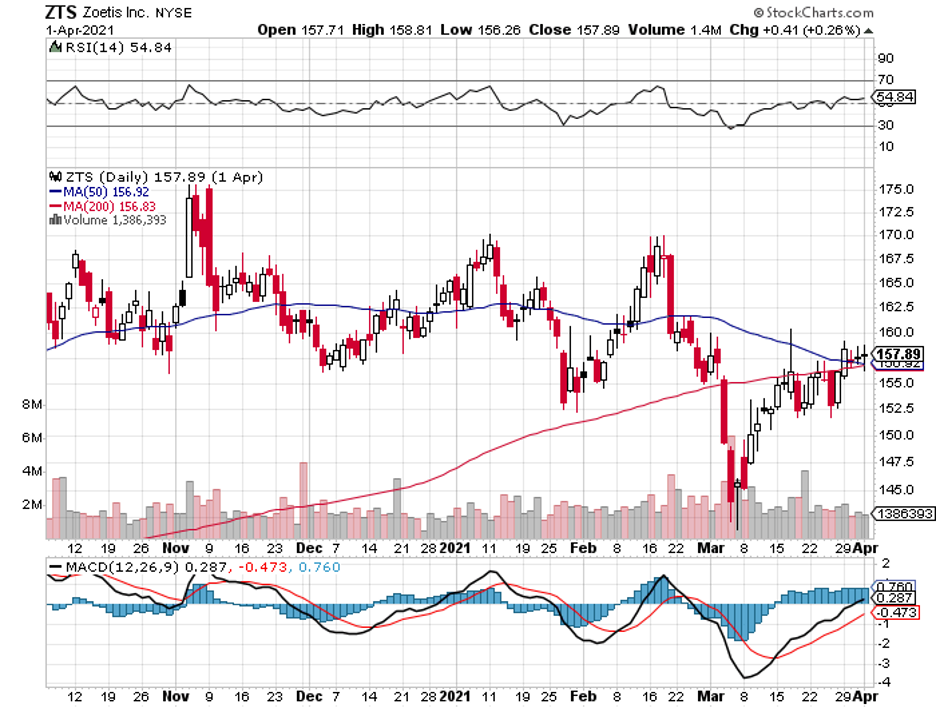
Mad Hedge Biotech & Healthcare Letter
September 1, 2020
Fiat Lux
Featured Trade:
(RACE TO THE FINISH LINE)
(PFE), (BNTX), (MRNA), (AZN), (INO), (ZTS), (MYL)

One of the leading companies in the COVID-19 vaccine race is getting closer to the finish line.
Pfizer (PFE) shocked the scientific community when it announced that it would be ready to submit its COVID-19 vaccine candidate, BNT162b2, for FDA approval by October.
The company said that it is now more than 50% done with the recruitment for its Phase 3 clinical trial, which requires 30,000 volunteers.
Earlier this year, Pfizer and its vaccine partner BioNTech (BNTX) were included in the US government’s Operation Warp Speed project. Although the two rejected government funding, their candidate is still included in the fast-track priority list of the FDA.
To date, the US government already secured a contract with Pfizer and BioNTech for 600 million doses of their vaccine, with the initial payment of $1.95 billion for the first 100 million doses.
Other countries across the globe have also shown faith in the science of Pfizer.
The UK government completed a deal with Pfizer for 30 million doses, while Japan ordered 120 million doses.
Since it has been preparing its manufacturing facilities while also conducting its trials, Pfizer is confident that it can produce 1.3 billion doses of BNT162b2 in 2021.
Given this timeline, it is possible for the company to launch its COVID-19 vaccine to the market by the fourth quarter of 2020, with peak sales of the product reaching $1.7 billion in 2021.
Revenue for BNT162b2 is expected to slide to $850 million by 2023, with the vaccine raking in an average of $500 million to $600 million in annual sales by then.
However, there is no such thing as a perfect solution.
A potential competitive disadvantage of Pfizer’s vaccine candidate lies in its storage requirements, which entail a storage temperature of −94°F.
While tertiary hospitals and laboratories can meet this requirement, it would make it difficult for traditional offices or pharmacies to store the product.
This shortcoming might prompt other governments and private institutions to consider other vaccine candidates with simpler storage requirements.
Although the results have yet to be released, early data show that competitors like Moderna (MRNA), AstraZeneca (AZN), and Inovio Pharmaceutical (INO) might offer less complicated solutions.
Outside its widely publicized COVID-19 vaccine efforts, Pfizer has been working on additional spinoffs to boost and diversify its revenue stream.
Investors of the company would agree that Pfizer is the kingpin of spinoffs.
A prime example of this is its animal healthcare Zoetis (ZTS) spinoff, which was established in 2013. Since then, the investors have experienced impressive returns with over 289% yields.
Now, Pfizer is aiming to replicate this feat with the $195 billion merger of its own off-patent and generic drugs unit Upjohn with Pennsylvania-based company Mylan (MYL).
The two companies are slated to form a mega-company, called Viatris, where Pfizer stakeholders will also receive shares.
Looking at its portfolio and pipeline candidates, Viatris is projected to generate approximately $19 billion to $20 billion in annual revenue and record $4 billion in free cash flow.
On top of the Viatris spinoff, Pfizer is also working on the Nasdaq IPO of Cerevel Therapeutics.
This is an interesting move from Pfizer since Cerevel is a neuroscience company, which focuses on diseases of the central nervous system like Alzheimer’s, Parkinson’s, and epilepsy.
Pfizer owns 25% stake of the neuro company while Bain Capital holds 75%. The two established Cerevel in 2018.
Just last July, Cerevel announced its merger with Arya Sciences Acquisition Corp II.
When the merger is finalized, the new company will be called Cerevel Therapeutics Holdings and will be under the ticker symbol “CERE” in Nasdaq. The deal is expected to be completed by the fourth quarter of 2020.
Although it will be a relatively unknown and new company, Cerevel is expected to receive at least $445 million to use for its growth by the end of the year.
Needless to say, this is expected to be another “Zoetis-in-the-making” strategy from Pfizer.
For 2020, Pfizer raised its revenue guidance and estimates that it can generate somewhere between $48.6 billion and $50.6 billion while recording an earnings per share of roughly $2.85 and $2.95.
Looking at its balance sheet, Pfizer has proven itself capable of weathering one of the most debilitating downturns since The Great Depression.
In fact, the company amassed revenue of $12 billion and showed off a respectable 12% operational growth in its biopharma unit in the first three months of this year.
In its second quarter earnings report, when the COVID-19 pandemic was already well underway, Pfizer raked in $11.8 billion in revenue.
With all the publicity surrounding the COVID-19 vaccine efforts, it is understandable that investors are buying at artificially high prices. However, Pfizer remains incredibly undervalued.
Pfizer’s star power would inevitably surge if BNT162b2 proves to be safe and effective. Even without the vaccine though, the company’s diverse portfolio and impressive acquisition strategies already make it a great buy.
Plus, its healthy dividend, which yields approximately 3.9%, is no doubt the icing on the cake for this incredibly undervalued stock.
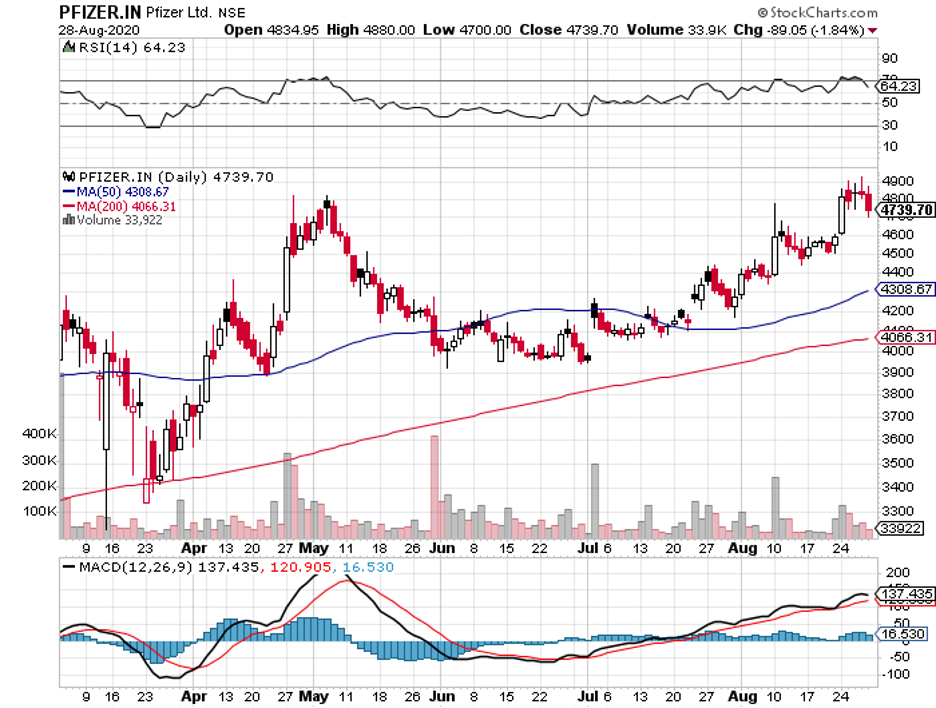
Mad Hedge Biotech & Healthcare Letter
August 20, 2020
Fiat Lux
Featured Trade:
(ZOETIS CONTINUES TO DELIVER MORE BANG PER BUCK)
(ZTS), (PFE)

The isolation brought by the pandemic-induced lockdowns has increased people’s reliance on their pets.
In the past months, stories have circulated around the country about the animal shelters being empty for the first time in recent history.
Aside from seeing this as a feel-good report, it can also be perceived as an investing opportunity. For businesses that specifically cater to these products and services, this phenomenon can easily translate into growing revenue.
One of the pet-related companies that benefited from it is Zoetis (ZTS).
Zoetis offers an extensive range of products that cater to both pets and even farm animals. Their list includes drugs, diagnostics, pesticides, and vaccines.
Originally, Zoetis was a subsidiary of biotechnology and healthcare giant Pfizer (PFE). It eventually broke away from its parent company and entered the stock market sometime in 2013.
For roughly seven years, Zoetis stock has impressively trounced the average market returns – and that momentum is projected to continue in the next five years.
In the second quarter of 2020, Zoetis reported $1.5 billion in revenue. This is flat compared to last year’s report, but it still surpassed the consensus Wall Street estimate of $1.36 billion.
In terms of net income, the company reported $377 million or $.079 for each share. This showed a modest increase from the $371 million or $0.77 per share it earned during the same period in 2019.
Despite the turbulent situation in the US, the market still served as one of the positive contributors in Zoetis’ second quarter.
The company recorded a 6% year over year jump in its revenue in the US, allowing it to reach $832 million. Unfortunately, revenue for its livestock products dropped by 18% year over year.
Sales for its companion-animal offerings also increased by 19%, with the climb largely attributed to the upsurge in demand for Zoetis’ growing Simparica brands.
In May, Zoetis lowered earnings expectations for 2020 due to the coronavirus pandemic.
However, Zoetis stock managed to exceed expectations. In fact, the animal healthcare stock is up by over 20% in the past three months.
Given its positive performance in the second quarter, Zoetis has increased its full-year 2020 guidance.
The company anticipates an annual revenue of $6.3 billion to $6.476 billion, which is a leap from its previous estimate of $5.95 billion to $6.25 billion.
Projections for its earnings per share is now in the range of $3.14 to $3.32 from the previous $2.80 to $3.07.
More importantly, Zoetis is looking into expanding its massive roster.
Since its most recent product Simparica Trio, which is a three-in-one preventive treatment for dogs, garnered much success in the market, the company is expected to release at least two new products before the year closes.
Aside from that, Zoetis may also expand into new markets within the animal healthcare sector.
One of the telltale signs is the company’s recent acquisitions, which include Performance Livestock Analytics, Platinum Performance, and other regional diagnostic laboratories.
In 2019, Zoetis forged a partnership with Colorado State University to study the livestock immune system. This could signify the company’s interest in another service, such as providing antibiotics to animals that are identified as sources of meat.
The demand for animal healthcare products and services has been consistently reliable, with the market estimated to reach $177.1 billion in 2027.
With the need for these goods spanning across the globe, companies that offer cater to these markets can expect a steady revenue stream and growth in the years to come.
Among the companies in this sector, Zoetis is the biggest with trailing 12-month revenues of roughly $6.3 billion and a market capitalization of $75.72 billion.
It prides itself on a notable profit margin of 25.4% and an impressive 63.6% return on equity. Adding these two metrics to the fact that the company has a 35.6% quarterly earnings growth year over year makes Zoetis a safe and long-term bet.
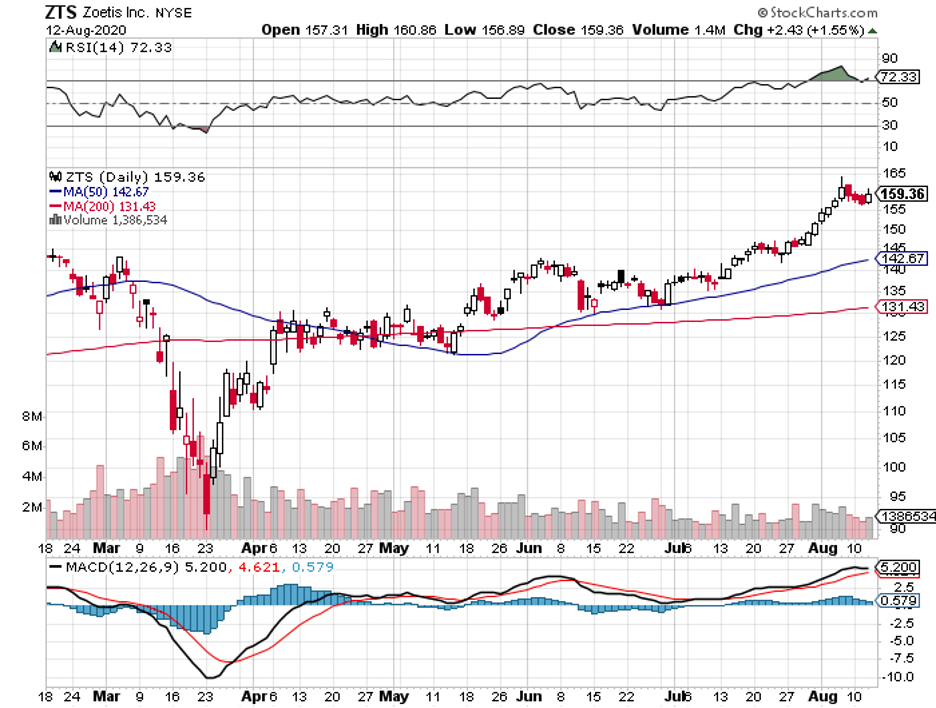
Mad Hedge Biotech & Healthcare Letter
May 21, 2020
Fiat Lux
Featured Trade:
(THERE IS STILL MORE BANG PER BUCK WITH ZOETIS)
(ZTS)

Zoetis (ZTS) has been an investor darling since it was spun off from Pfizer way back in 2013. From day one, since this animal healthcare stock went public, shares have soared by 382%.
This stock’s popularity among growth investors stemmed from two emerging trends today. The first is the “humanization” of our pets through healthcare. The second is the rise in global demand for animal protein.
Both tailwinds have been responsible for the steady growth of Zoetis and are anticipated to continue to do so in the years to come.
With everything that has happened since we welcomed 2020, is Zoetis still a good stock to buy?
Earlier this month, Zoetis released its fourth-quarter earnings report for 2019. As usual, the company once again impressed its investors by beating estimates.
The company reported a quarterly revenue of $1.7 billion, indicating a 7% improvement from its performance in the same quarter in 2018.
Adjusted net income came in at $440 million, breaking down to earnings per share of $0.92.
In comparison, Wall Street estimates pegged Zoetis’ quarterly revenue at $1.6 billion with an EPS of $0.88.
Notably, Zoetis’ international business segments and its US market are practically equal in terms of size. Its US market raked in $861 million in revenue, showing off a 6% boost in this quarter. Meanwhile, its international sales increased by 9% to reach $791 million.
Although all these are enough to make investors happy, Zoetis’ 2020 guidance gave some of its investors pause.
According to the company, it estimates a jump in its annual growth somewhere between 5.5% and 8%, pushing its revenue from $6.3 billion to reach an amount somewhere between $6.65 billion and $6.8 billion.
However, this projection has been met with skepticism in light of COVID-19.
Looking at its reports, roughly 3% or $200 million of Zoetis’ sales last year came from China.
Despite this, Zoetis appears to be confident that it can hit its goals this year.
The company’s companion animal business, which primarily sells medicines for cats and dogs, picked up the slack from the decline of its beef and dairy cattle markets.
In fact, revenue from the companion animal arm showed an 18% jump year over year and reached $784 million.
One of the main drivers in this sector is Zoetis’ dermatology brands, Apoquel and Cytopoint. Both are estimated to bring in roughly $700 million in annual sales. Boosting this momentum are the company’s parasiticide items like ProHeart 12 and Simparica.
However, it’s the launch of Simparica Trio that generated excitement among Zoetis investors.
Simparica Trio is the company’s new chewable “triple combination parasiticide for dogs.” According to the company’s guidelines, this product is expected to add at least $150 million in revenue for the last three quarters of 2020.
This new drug’s appeal lies in the fact that it can simplify the lives of pet owners. Simparica Trio only needs to be administered once a month.
After that, the pill can be relied on as a preventive measure against heartworm disease. It can also control ticks, intestinal nematodes, and fleas in dogs. With Simparica Trio, pet owners no longer need to buy and administer multiple products.
To date, this medicine has received regulatory approval in Canada and the European Union. It’s expected to receive US approval in the first half of this year.
Simparica Trio is also expected to broaden Zoetis’ market share in the parasiticides sector, where it only ranks fourth.
Zoetis is also looking to explore the lucrative market of osteoarthritis treatments for cats and dogs.
Taking a page off the world’s top-selling drug, Abbott Laboratories’ (ABT) blockbuster rheumatoid arthritis treatment Humira, the animal health company plans to create pain medication based on the same technology. If Zoetis succeeds, then it’ll be the first company to address this unmet market.
Apart from these, Zoetis will also expand its services to include diagnostics as well as digital and data analytics.
In fact, the company has started investing in “precision livestock farming.” A good example of this initiative is its Smartbow technology, which is a dairy cow monitoring system that utilizes motion detectors. These are attached to the animals’ ears in an effort to identify patterns that can signify health issues.
Zoetis has been one of the most attractive stocks on the market since 2013.
While a lot of healthcare and biotechnology companies are at risk for increased volatility this year especially with the US presidential election, this animal health stock should be relatively resistant to political drawbacks.
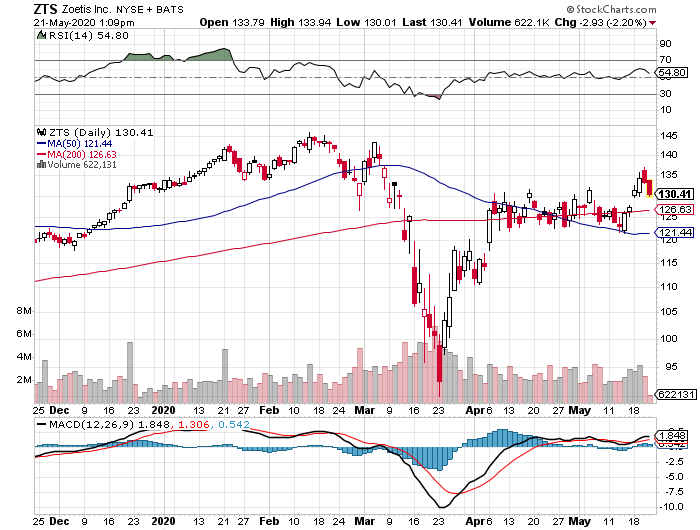
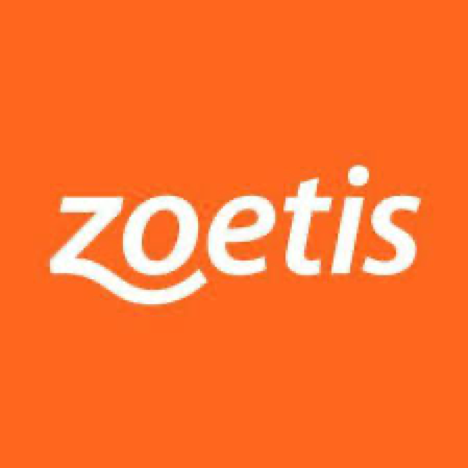
Mad Hedge Biotech & Healthcare Letter
March 3, 2020
Fiat Lux
Featured Trade:
(WHY ZOETIS STILL HAS MILES TO RUN)
(ZTS)

Zoetis (ZTS) has been an investor darling since it was spun off from Pfizer way back in 2013. From day one, this animal healthcare stock went public, shares have soared by a stunning 382%.
This stock’s popularity among growth investors stemmed from two emerging trends today. The first is the “humanization” of our pets through healthcare. The second is the rise in global demand for animal protein.
Both tailwinds have been responsible for the steady growth of Zoetis and are anticipated to continue to do so in the years to come.
With everything that has happened since we welcomed 2020 though, is Zoetis still a good stock to buy?
Earlier this month, Zoetis released its fourth-quarter earnings report for 2019. As usual, the company once again impressed its investors by beating estimates.
The company reported a quarterly revenue of $1.7 billion, indicating a 7% improvement from its performance in the same quarter in 2018.
Adjusted net income came in at $440 million, breaking down to earnings per share of $0.92.
In comparison, Wall Street estimates pegged Zoetis’ quarterly revenue at $1.6 billion with an EPS of $0.88.
Notably, Zoetis’ international business segments and its US market are practically equal in terms of size. Its US market raked in $861 million in revenue, showing off a 6% boost in this quarter. Meanwhile, its international sales increased by 9% to reach $791 million.
Although all these are enough to make investors happy, Zoetis’ 2020 guidance gave some of its investors pause.
According to the company, it estimates a jump in its annual growth somewhere between 5.5% and 8%, pushing its revenue from $6.3 billion to reach an amount somewhere between $6.65 billion and $6.8 billion.
However, this projection has been met with skepticism in light of the coronavirus disease 2019 (COVID19).
Looking at its reports, roughly 3% or $200 million of Zoetis’ sales last year came from China.
Despite this, Zoetis appears to be confident that it can hit its goals this year.
The company’s companion animal business, which primarily sells medicines for cats and dogs, picked up the slack from the decline of its beef and dairy cattle markets.
In fact, revenue from the companion animal arm showed an 18% jump year over year and reached $784 million.
One of the main drivers in this sector is Zoetis’ dermatology brands, Apoquel and Cytopoint. Both are estimated to bring in roughly $700 million in annual sales. Boosting this momentum are the company’s parasiticide items like ProHeart 12 and Simparica.
However, it’s the launch of Simparica Trio that generated excitement among Zoetis investors.
Simparica Trio is the company’s new chewable “triple combination parasiticide for dogs.” According to the company’s guidelines, this product is expected to add at least $150 million in revenue for the last three quarters of 2020.
This new drug’s appeal lies in the fact that it can simplify the lives of pet owners. Simparica Trio only needs to be administered once a month.
After that, the pill can be relied on as a preventive measure against heartworm disease. It can also control ticks, intestinal nematodes, and fleas in dogs. With Simparica Trio, pet owners no longer need to buy and administer multiple products.
To date, this medicine has received regulatory approval in Canada and the European Union. It’s expected to receive US approval in the first half of this year.
Simparica Trio is also expected to broaden Zoetis’ market share in the parasiticides sector, where it only ranks fourth.
Zoetis is also looking to explore the lucrative market of osteoarthritis treatments for cats and dogs.
Taking a page off the world’s top-selling drug, Abbott Laboratories’ (ABT) blockbuster rheumatoid arthritis treatment Humira, the animal health company plans to create pain medication based on the same technology. If Zoetis succeeds, then it’ll be the first company to address this unmet market.
Apart from these, Zoetis will also expand its services to include diagnostics as well as digital and data analytics.
In fact, the company has started investing in “precision livestock farming.” A good example of this initiative is its Smartbow technology, which is a dairy cow monitoring system that utilizes motion detectors. These are attached to the animals’ ears in an effort to identify patterns that can signify health issues.
Zoetis has been one of the most attractive stocks on the market since 2013.
While a lot of healthcare and biotechnology companies are at risk for increased volatility this year especially with the US presidential election, this animal health stock should be relatively resistant to political drawbacks.
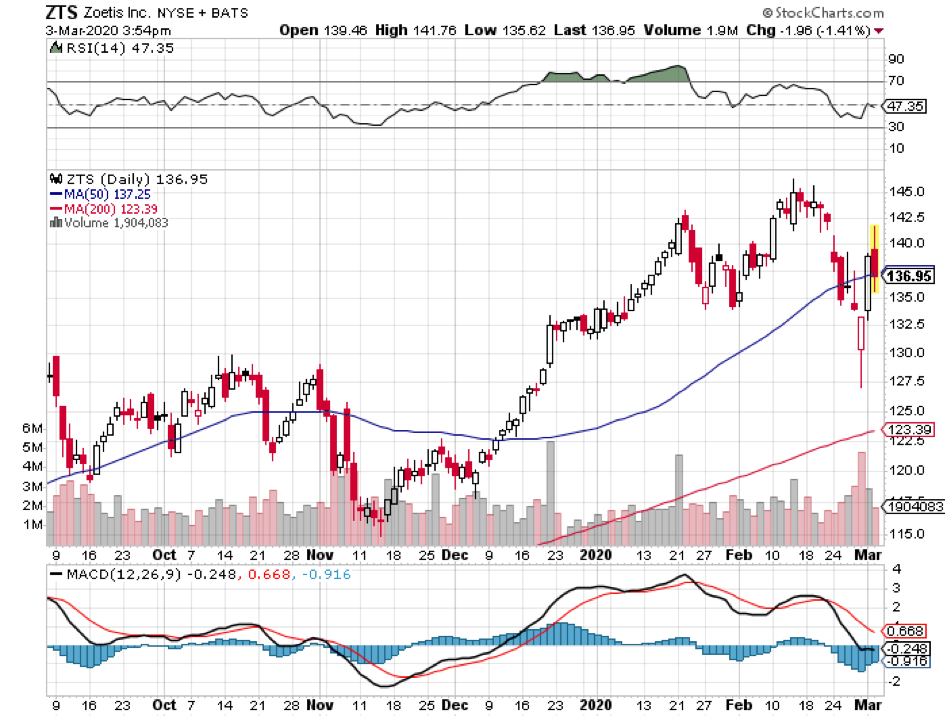

Legal Disclaimer
There is a very high degree of risk involved in trading. Past results are not indicative of future returns. MadHedgeFundTrader.com and all individuals affiliated with this site assume no responsibilities for your trading and investment results. The indicators, strategies, columns, articles and all other features are for educational purposes only and should not be construed as investment advice. Information for futures trading observations are obtained from sources believed to be reliable, but we do not warrant its completeness or accuracy, or warrant any results from the use of the information. Your use of the trading observations is entirely at your own risk and it is your sole responsibility to evaluate the accuracy, completeness and usefulness of the information. You must assess the risk of any trade with your broker and make your own independent decisions regarding any securities mentioned herein. Affiliates of MadHedgeFundTrader.com may have a position or effect transactions in the securities described herein (or options thereon) and/or otherwise employ trading strategies that may be consistent or inconsistent with the provided strategies.
This site uses cookies. By continuing to browse the site, you are agreeing to our use of cookies.
OKLearn moreWe may request cookies to be set on your device. We use cookies to let us know when you visit our websites, how you interact with us, to enrich your user experience, and to customize your relationship with our website.
Click on the different category headings to find out more. You can also change some of your preferences. Note that blocking some types of cookies may impact your experience on our websites and the services we are able to offer.
These cookies are strictly necessary to provide you with services available through our website and to use some of its features.
Because these cookies are strictly necessary to deliver the website, refuseing them will have impact how our site functions. You always can block or delete cookies by changing your browser settings and force blocking all cookies on this website. But this will always prompt you to accept/refuse cookies when revisiting our site.
We fully respect if you want to refuse cookies but to avoid asking you again and again kindly allow us to store a cookie for that. You are free to opt out any time or opt in for other cookies to get a better experience. If you refuse cookies we will remove all set cookies in our domain.
We provide you with a list of stored cookies on your computer in our domain so you can check what we stored. Due to security reasons we are not able to show or modify cookies from other domains. You can check these in your browser security settings.
These cookies collect information that is used either in aggregate form to help us understand how our website is being used or how effective our marketing campaigns are, or to help us customize our website and application for you in order to enhance your experience.
If you do not want that we track your visist to our site you can disable tracking in your browser here:
We also use different external services like Google Webfonts, Google Maps, and external Video providers. Since these providers may collect personal data like your IP address we allow you to block them here. Please be aware that this might heavily reduce the functionality and appearance of our site. Changes will take effect once you reload the page.
Google Webfont Settings:
Google Map Settings:
Vimeo and Youtube video embeds:
